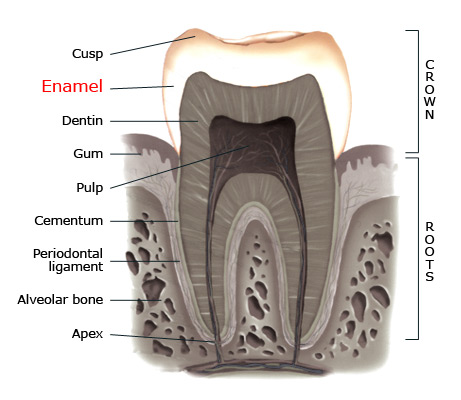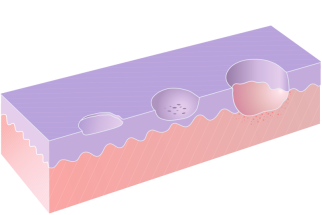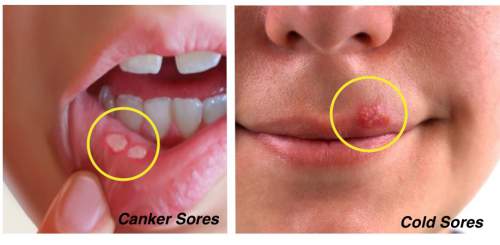Did your mother tell you to gargle salt water in your mouth when you had ulcers? Well, these old wives tales about salt healing mouth ulcers will be under scrutiny today! Regardless, I personally had ulcers in my mouth since young and spamming salt on to the region of open raw flesh can send tears trickling down my cheeks. Salt is a natural remedy I used every single time and, without fail, my ulcers would recover in a couple of days.
Intrigued by the workings of salt and the ulcers, I am here today to investigate how exactly salt works (and hopefully give me an idea on how to expedite the recovery process, I don’t like to have this large ulcer under my tongue 😦 ).
Can you spot the ulcer?
According to Today’s Dentistry, salt water mouthwashes are excellent treatment for wounds in the mouth. Salt is a natural disinfectant and is able to destroy bacteria infested in the region where your ulcers are. In addition, salt reduces swelling as well. Using salt for short-term remedies to cure your mouth ulcer is good, however, the long-term ones can damage the enamel of your teeth because the acidity will slowly erode and soften your teeth’s enamel. For those who are unsure of what an enamel is, it is a layer of protective substance that covers the crown of a tooth.

Yeap, that is your enamel protecting your crown.
According to Science Tribune, the use of salt can be dated back to the Egyptians in the 1600 B.C. where in Medical Sciences, salt was believed to dry out and disinfect wounds. Fast forward to almost 2000 years ago, the Greeks discovered that salt affected basic body functions like digestion and excretion and Hippocrates frequently used salt for treatment. The use of salt in medical treatment can be seen propagating towards the presence to Roman times, into the Arab world, and the in the Middle Ages.
Before we venture into the wonders of salt, we first need to understand how mouth ulcers came about.
Also known as Canker sores, mouth ulcers are small lesions that develop in areas of your mouth including your inner cheeks, gums, lips, and tongue. The most common causes of Canker sores are local trauma and aphthous stomatitis. According to Medline Plus, there are three types of sores: Cold sores, Canker sores, and sores of a more malignant disease. Before delving into salt treatment, I believe it is important to establish the kind of sore you have in your mouth.
Cold sores are caused by HSV-1 (Herpes simplex virus type 1, a kind of sexually transmitted disease that results in oral herpes. If you are wondering, HSV-2 is the one that causes genital herpes) and are very contagious. These sores are generally red in appearance and blisters usually crusted over. It is important to seek medical attention because medication such as Acyclovir, Famciclovir are able to target and wipe out the HSV-1 population. Gargling salt might further irritate your blister and make the infection worse.
Canker sores, on the other hand, are not contagious are usually pale or yellow enclosed by a red outer ring.
Well, have you ever wondered why are Canker sores yellow?
Ulcers are breaks in the skin or the mucous membrane (one of the superficial layers of tissues that can secrete mucus, a natural lubricant in our body), starts to undergo disintegration. When the necrosis (or the death) of your mucous membrane penetrates beyond the connective tissue border (the deeper level in which connects, supports, binds or separates other tissues and organs), it can damage your lamina propria (another layer of your connective tissues).

The photo above is a diagrammatic representation of ulceration (right) where necrosis of mucous membrane (purple) beyond the connective tissue border (pink) can be seen.
Erosions involving the epithelial layer (purple) are often red in appearance, and therefore, the superficial cold sores are always red because the damage does not go beyond the connective tissues. The red color is a derivative of the exposed lamina propria (pink). However, during ulceration, the connective tissue has been eroded as well. These lesions, in response to an open wound, triggers the body to secrete fibrin (a natural type of protein involve in the stitching up of wounds during a small tear or break) and the fibrinous exudate gives the ulcer a yellow-grey color. Inflammation to the surrounding tissues gives the ulcer a red halo.
Causes of Canker sores are currently not known, but stress, hormone changes, lack of vitamins are factors thought to cause them.

With reference to the photo above, Canker sores are yellow or pale in color circumferenced by a red ring unlike Cold sores, which look blistered and red in nature.
For those interested in Mouth Sores, these are self-limiting symptoms that will go away on its own, sometimes for up to 6 weeks. However, if you are concerned, I suggest you have an appointment with your medical practitioner who can advise you better.
Similarly, Canker sores are self-limiting and take no more than 10 days to recover. However, those with Canker sores should avoid food that can irritate the sore, including spicy and sharp tasting foods (like pineapples).
So how does the salt works?
Well, none of the journals I found or articles I saw online gave me insights as to how salt facilitate the recovery. But based on several facts below, I will be hypothesizing instead.
According to Eric Shapira, D.D.S., salt temporarily increases the pH balance of your mouth. Majority of the bacteria in your mouth prefer a slightly acidic environment, by creating an alkaline environment, bacteria struggle to survive and breed. Thereby inhibiting excessive growth of bacteria that can infect your ulcers.
Lastly, salt is an isotonic solution. That is, the solution contains the same salts and minerals in our bodies at the equal concentrations which means the salt solution you use for gargling will not affect or further aggravate the wound.
Because salt acts as an antiseptic and does not exacerbate the wounds, I hypothesized that salt sets the condition for the connective tissue to rebuild quickly, while keeping infections at bay. However, there are some questions I would raise with regards to salt and the interaction.
Wouldn’t the higher salt concentration result in the leaching of scarce minerals out from the connective tissues?
Or wouldn’t the excess salt get absorbed into tissues and overstimulates the other chemicals?
Does it mean that in an aseptic environment, healing becomes a lot quicker? But the mouth is never a sterile environment. Is there a mechanism in which facilitates faster healing?
What if some of these micro-floral we killed from the salt overdose play a crucial role in healing?
Wow, I hope someone out there and perhaps do a study on this and tell me how exactly salt works!



Nice post. Well what can I say is that these is an interesting and very informative topic on mouth blister treatment